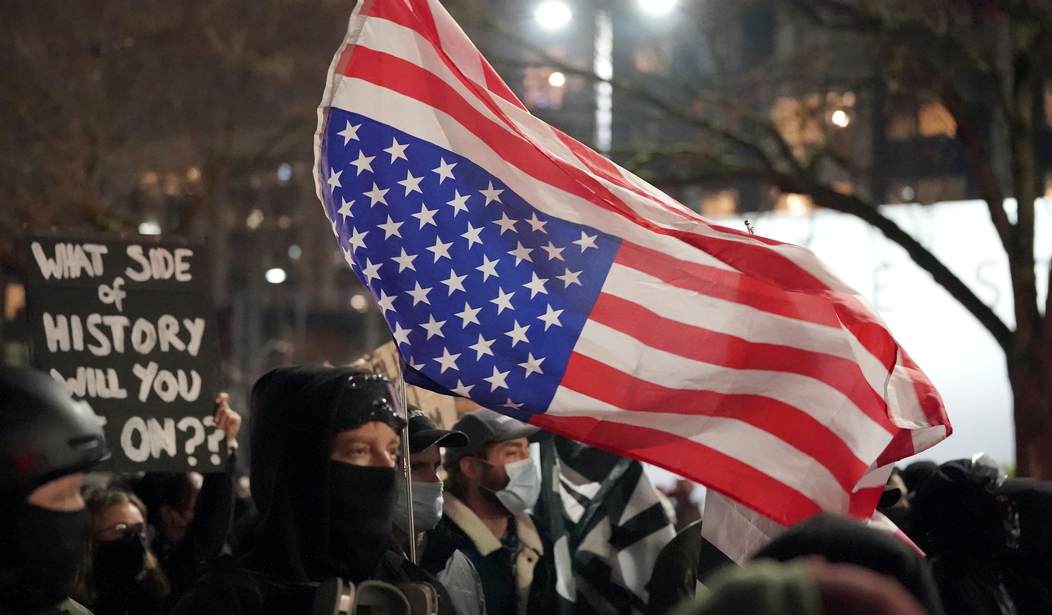Former Minneapolis Police Officer Derek Chauvin may not escape prosecution for one of the three charges against him for causing the death of George Floyd, but contrary to public opinion, the case against him is not cut and dried. Though radio stations have solemnly gone quiet for nearly nine minutes to remind Americans of the time Chauvin had his knee on Floyd’s neck, Black Lives Matter fire-setters and looters with their violent antifa allies burned parts of American cities in retaliation for his death, and cops were forced to kneel, it turns out there’s a lot we didn’t know about the case.
Why not? There’s only one explanation. Prosecutors didn’t tell you. Antifa-friendly Attorney General Keith Ellison, who picked those multiple private attorneys from white-shoe firms to replace regular Hennepin County prosecutors, didn’t tell you. The media obviously didn’t tell you. And the threatening mob that recorded the horrific site of George Floyd handcuffed and prone on a Minneapolis street didn’t tell you. Black Lives Matter certainly didn’t tell you. This is the group that overtly lied about the deaths of Trayvon Martin, Michael Brown, Breonna Taylor, Patrick Kimmons, Jacob Blake, and others.
Unfunny comedian Chelsea Handler may want to rush to judgment because “there is video of him” killing George Floyd.
But is there?
So pathetic that there is a trial to prove that Derek Chauvin killed George Floyd when there is video of him doing so.
— Chelsea Handler (@chelseahandler) March 30, 2021
Many things have been revealed during the nearly two-week-long trial of Chauvin. We’re betting you didn’t know most of them. Here are just nine examples.
1. Chauvin Didn’t Have His Knee on Floyd’s Neck
Midway through the second week of testimony, defense attorney Eric Nelson showed video from police body-worn cameras from a different angle showing Derek Chauvin’s knee was on Floyd’s shoulder and upper back, not his neck. Prosecutors immediately began changing their verbiage from “neck” to “neck area,” according to Andrew Branca of Legal Insurrection, who is listening to the trial as I am.
It’s possible Chauvin’s knee slipped to Floyd’s neck at some point before police could “load and scoot” him for medical help, but a different angle showed that he had his knee on Floyd’s shoulder blade.
But wait, didn’t the police chief testify this was against police protocol? Yes. Was this an accurate depiction of what police can do? No. As the prosecution’s own use-of-force expert testified.
2. The Cops Didn’t Use as Much Force as They Could Have
The prosecution’s use-of-force expert testified in cross-examination by Chauvin’s attorney that police could have used their tasers on Floyd, but chose not to, since by that time the knee hold was working.
3. We Still Don’t Know How George Floyd Died
As Andrew Branca has pointed out, the prosecutors have alluded throughout their case to apparent asphyxia as the culprit in Floyd’s death. They are attempting to lead jurors to conclude that the only way that asphyxia could have occurred was by Derek Chauvin’s knee on Floyds “neck area,” which we now know was the shoulder and back area, not the neck per se.
We know Floyd had a deadly cocktail of drugs in his system. It’s believed that this same cocktail of meth and fentanyl are what sent Floyd to the hospital, where he nearly died, only two months before. Fentanyl causes asphyxia.
4. Drugs Were Found in SUV and Cop Car
Pills found in the Mercedes SUV and the police squad car, where Floyd had been for a brief time, had meth and fentanyl in them, which he was believed to have eaten to hide evidence from cops.
5. Floyd Was Using Drugs Again
Floyd’s girlfriend Courtney Ross testified that “Floyd,” as she called him, was living with friends from Salvation Army’s Harbor Light shelter, where the 6’4″, 220-lb. man served as a security officer. She said he was sad because most of his friends had lost their jobs due to pandemic shutdowns. She testified that he was using drugs again after a short sober period.
6. George Floyd Was With His Drug Dealer When Cops Came
George Floyd was sitting in a Mercedes SUV with his reputed drug dealer. Testimony shows that Morries Hall first tried to use fake $20 bills at the local store, and when that didn’t work, sent Floyd inside to use them. It’s entirely possible that Hall urged Floyd to eat the drugs to hide the evidence, which would have sent the dealer to a much longer jail sentence. Indeed, audio from a police video was introduced into court that seems to show Floyd telling cops “I ate too many drugs,” though prosecutors believe he told police “I ain’t doing no drugs.”
7. Floyd’s Drug Dealer Took the 5th
Morries Hall’s attorney announced to the Chauvin judge that he would not testify. Hall invoked his 5th Amendment rights because it’s entirely possible he could be found to have given Floyd his lethal dose of fentanyl.
8. Derek Chauvin Weighed 140 Pounds, Floyd 223
Chauvin and his partner came to back up two other cops who had tussled with Floyd in an attempt to get him in the back of their squad car. It was a priority-one call for a non-compliant, suspected drug-addled perpetrator who had just fought with cops. They encountered Floyd, whom his girlfriend testified worked out every day with weights and played sports. Chauvin weighed 140 pounds and is 5’9″, compared to Floyd’s 223 pounds and 6’4″ frame.
9. The Hostile Crowd Could Have Contributed to Floyd’s Death
Testimony in cross-examination of the prosecution’s medical care training expert, Nicole MacKenzie, revealed that the hostile crowd could have contributed to Floyd’s death. How? Due to the hostility, threats, and the possibility that the crowd could get violent, the Minneapolis officers had to “load and scoot” Floyd to get to a safe area where they would meet paramedics and treat him. Paramedics arrived at the previous location and had to find where Floyd had been moved to, burning up a crucial eleven minutes.
The first week of the trial was filled with crying witnesses meant to elicit sympathy for Floyd but not much else. In fact, the prosecution’s case was “pound the table” weak in the first few days. The facts and expert witnesses introduced in the second week of the trial have been skillfully used by defense attorney Eric Nelson. While publications like The LA Times say the prosecution “is scoring” big, Nelson, though outnumbered by prosecutors at least 12 to one, has managed to use the prosecution’s paid-for expert witnesses to create doubt in the state’s case. In fact, one expert was so helpful to the defense that Nelson announced he would call her again for the defense when he presents Chauvin’s case.
Now the question is will a jury of Minneapolis residents, who have lived through the George Floyd riots and looting, see any doubt created in a case that Chelsea Handler says is unnecessary and “pathetic” because “there is a video of [Derek Chauvin killing] him.”
Is there?










Join the conversation as a VIP Member